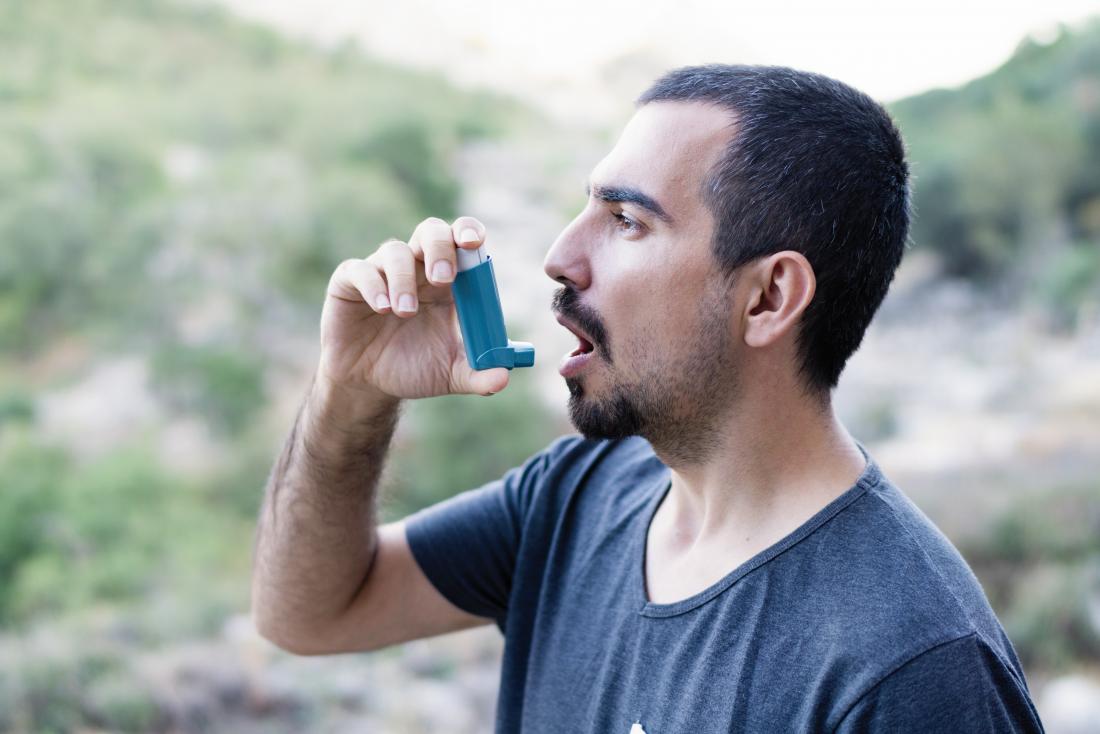People may wheeze due to a long-term condition, such as asthma or chronic obstructive pulmonary disease (COPD), or a short-term condition, such as bronchitis or pneumonia.
Expiratory wheezing occurs when a person breathes out, while inspiratory wheezing happens when they breathe in.
In this article, learn more about the differences between expiratory and inspiratory wheezing and the causes of each type.
Expiratory vs. inspiratory wheezing

Inspiratory wheezing occurs during inhalation.
Expiratory wheezing means that the wheeze happens on an exhale of breath. Inspiratory wheezing is a wheeze on the inhale.
Wheezing can be either expiratory, inspiratory, or both. Expiratory wheezing is more common and may mean that a person has a mild blockage causing the wheezing.
If people have both expiratory and inspiratory wheezing, this may be because their airways are narrower, and it could indicate a more severe issue.
The cause of the wheezing often depends on its location in the airways, for example, whether it comes from the upper airways in the neck or from lower in the chest.
Stridor is the term for a specific type of inspiratory wheezing, which can signal that the upper airway has become blocked.
Causes
Many different conditions can cause expiratory and inspiratory wheezing. A condition that obstructs the upper airway is more likely to cause an inspiratory wheeze, but it can also lead to expiratory wheezing.
Asthma
Asthma is a lung condition that can cause wheezing. People with acute asthma may experience both inspiratory and expiratory wheezing or just one of them.
People with asthma may also experience:
Genetics, respiratory infections, or environmental factors can cause asthma.
Chronic obstructive pulmonary disease
COPD is a lung condition. The airways of people with COPD become inflamed, which means that less air can flow into and out of the lungs, making breathing difficult.
Alongside wheezing, symptoms of COPD can include:
- shortness of breath
- a blue tinge to the lips or the base of the fingernails
- fatigue
- phlegm
- frequent coughing
Smoking causes roughly 85–90% of COPD cases. Over time, frequent exposure to air pollution and chemical fumes can also cause COPD. A few causes of COPD are genetic.
Vocal cord dysfunction
Vocal cord dysfunction, also called paradoxical vocal fold movement, happens when the vocal cords do not open as they should.
The symptoms can be similar to those of asthma and include:
- a feeling of tightness in the throat
- coughing
- difficulty breathing
- a hoarse voice or changes to the voice
Bronchitis

Coughing and a low fever are potential symptoms of bronchitis.
Respiratory infections, such as bronchitis, can cause wheezing as well as:
- coughing that produces mucus
- shortness of breath
- low fever
- chest pain
Acute bronchitis is temporary and can last from a few days to weeks. People with chronic bronchitis have repeat infections that can last for several months.
Pneumonia
Pneumonia is an infection of the lungs that causes them to fill with fluid. This fluid can obstruct the airways and cause wheezing. People may also notice that their breathing is shallow or rapid.
Other symptoms can include:
- a cough that produces phlegm or, in some cases, blood
- fever and chills
- feeling confused
- chest pain that worsens when breathing deeply or coughing
- nausea
Anaphylaxis
Anaphylaxis is a severe allergic reaction to a substance or insect bite. Along with wheezing, people with anaphylaxis may find it difficult to breathe.
Other symptoms of anaphylaxis include:
- swollen lips, tongue, or throat
- rash or itching
- feeling faint or dizzy
- stomach pain
Anaphylaxis can be life-threatening, so people should seek emergency medical attention if they experience the symptoms above.
Lung cancer
Lung cancer can cause wheezing, coughing, and shortness of breath. Other signs to look out for include:
- fatigue
- unexplained weight loss
- pain in the chest
- coughing blood
- a hoarse voice
- recurrent infections, such as pneumonia
In severe cases, wheezing can sometimes be a sign of a collapsed airway or occur as a result of the inhalation of toxic smoke or chemicals.
Diagnosis
A doctor will first listen to a person’s breathing to determine whether the wheezing is expiratory or inspiratory.
To diagnose the underlying cause of the wheezing, a doctor may:
- take a medical history
- do a physical examination
- take an X-ray of the chest
- test how the individual inhales and exhales air (a spirometry test)
- do a blood test to check for infection
Treatment

A person with asthma can use an inhaler to treat wheezing.
A person’s treatment options will vary depending on the cause of the wheezing.
People with anaphylaxis will need an immediate injection of epinephrine. Anyone with a severe allergy should carry two epinephrine auto-injectors with them at all times.
Asthma can be a lifelong condition, but people can manage their symptoms with a variety of treatments. These can include medications that a person takes through an inhaler or in the form of a pill or injection. Many of these medicines work to reduce swelling and relax the muscles in the airways.
Treatment for COPD can include daily medication, either in pill form or through an inhaler.
People with COPD may also require an extra oxygen supply through the nose or mouth.
For conditions affecting the vocal cords, speech therapy or deep breathing exercises can help relax the muscles in the throat.
People with acute bronchitis will usually recover within a few days or weeks. Taking an over-the-counter anti-inflammatory drug, such as ibuprofen, can help speed this process.
A doctor may prescribe antibiotics for bacterial infections. People with chronic bronchitis may need to take prescribed medication, make lifestyle changes, or, in some cases, use an extra oxygen supply.
Treatment for lung cancer will depend on the stage of the disease and how it has spread in the body. A team of doctors will create an individualized treatment plan that may involve surgery, chemotherapy, or radiation therapy.
When to see a doctor
If a person is wheezing for an unknown reason or thinks that they might have asthma or COPD, they should see a doctor.
Anyone who notices signs of pneumonia, has difficulty breathing, or sees that their skin has turned blue should seek emergency help.
People should also seek emergency medical attention if they are having an asthma attack or have started wheezing after:
- getting an insect sting or bite
- taking medication
- having an allergic reaction
If people have had an anaphylactic reaction, they should seek emergency help immediately, even if they have taken an epinephrine injection and are feeling better.
Anyone with long-lasting or repeat bronchitis infections should see their doctor for treatment.
Summary
People may experience expiratory and inspiratory wheezing from lung conditions, such as asthma or COPD. Temporary conditions, such as respiratory infections, can also cause both types of wheezing.
Expiratory wheezing is more common and may be a result of a mild infection affecting the airways. An obstruction of the upper airways can cause inspiratory or expiratory wheezing.
If people are experiencing both expiratory and inspiratory wheezing, they may have a more serious issue and should seek medical help.
If people are wheezing for no known reason, are having difficulty breathing, or have a tightening of the chest, they should seek medical help immediately.
